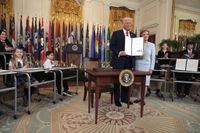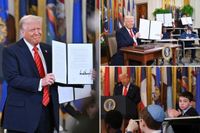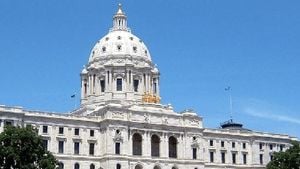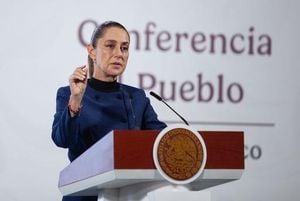In a bold move signaling major shifts in U.S. education policy, President Donald Trump signed an executive order on March 20, 2025, directing the U.S. Department of Education (DOE) to begin winding down operations. This order represents one of the most significant attempts to downsize the federal government in American history. Addressing an audience filled with Republican governors and students during a White House ceremony, Trump criticized the DOE for its "breathtaking failures" since its establishment in 1979 under President Jimmy Carter.
Trump asserted, “We’re going to be returning education, very simply, back to the states, where it belongs.” This pivot aims to transfer authority over education from federal oversight back to local and state governments, a move he argues is essential for improving the educational outcomes for American students. Flanked by influential conservative leaders including Texas Governor Greg Abbott and Florida Governor Ron DeSantis, Trump expressed that letting states manage education will help restore accountability and efficiency.
According to the executive order, all remaining programs at the DOE will avoid promoting themes of gender ideology and principles of diversity, equity, and inclusion (DEI). The directive emphasizes that federal support for education should be refocused, with Trump clarifying that critical student programs such as loans, Pell Grants, and Title I funding will be preserved but may be redistributed among various government agencies.
The DOE currently manages a staggering student loan portfolio exceeding $1.6 trillion, making it comparable in size to some major banking institutions such as Wells Fargo. Trump likened the DOE's operation to a banking institution, saying, “The Department of Education is not a bank, and it must return bank functions to an entity equipped to serve America’s students.” This rhetoric reflects ongoing frustrations about the profusion of funding without commensurate educational improvement.
Critics of Trump's executive order have been quick to respond, voicing concerns over the implications for student protections and educational equity. Representative Bobby Scott, a Democrat from Virginia, highlighted that dismantling the DOE could exacerbate existing disparities among students, particularly those from low-income backgrounds, and those with disabilities. Scott emphasized that the DOE was created partly to ensure civil rights protections and that erasing federal oversight could jeopardize these guarantees.
Despite fears of legal challenges looming over the order, White House press secretary Karoline Leavitt defended the initiative, stating that it aims to “greatly minimize the agency” while keeping critical functions intact. The DOE's annual budget, which stands at $79 billion designated for discretionary spending, has been an ongoing point of contention. Critics argue that this financial support does not yield adequate results in educational outcomes, particularly in comparison to other nations.
Already, the agency has suffered significant reductions in workforce with over 1,300 employees laid off earlier this month as part of a broader strategy aimed at cutting bureaucratic waste. When Trump assumed office, the DOE employed approximately 4,133 people, but that number has now dwindled to about 2,183. These cuts fuel concerns about the department's ability to fulfill its core functions, especially amid ongoing discussions about student aid and educational rights.
Randi Weingarten, president of the American Federation of Teachers, voiced her opposition succinctly, stating, “See you in court.” Her reaction mirrors the sentiments of many educators and advocates who fear that Trump’s move to close the DOE will dismantle crucial protections for students across the country.
Trump's administration, characterized by a focus on minimizing the federal bureaucracies, may indeed encounter legal hurdles as it attempts to navigate the complexities of federal education law. While many conservatives may welcome the closure as a return to state empowerment, others fear it represents a dismantling of vital educational frameworks that have been established to support students nationwide.
As protests formed outside the DOE's headquarters shortly after the announcement — gathering voices rallying against the department's closure — key stakeholders in the educational system, including unions and educators, are preparing for intense legal battles to preserve their rights and ensure that educational equity remains a priority.
The upcoming weeks are likely to see concerted efforts to ensure that core educational responsibilities, such as ensuring that every student has access to a free public education as stipulated by the Individuals with Disabilities Education Act (IDEA), are not lost in the shuffle of bureaucratic downsizing.
Trump concluded his remarks by reflecting on the longstanding desire among many to shift educational authority back to the states, stating, “People have wanted to do this for many, many years, for many, many decades take care of our teachers, saying he doesn’t mind if they join unions and that he thinks teachers can collaborate with parents better on the local level.” The president’s endeavors promise to generate significant political discourse as stakeholders brace for the direct impact on education and federal funding.





